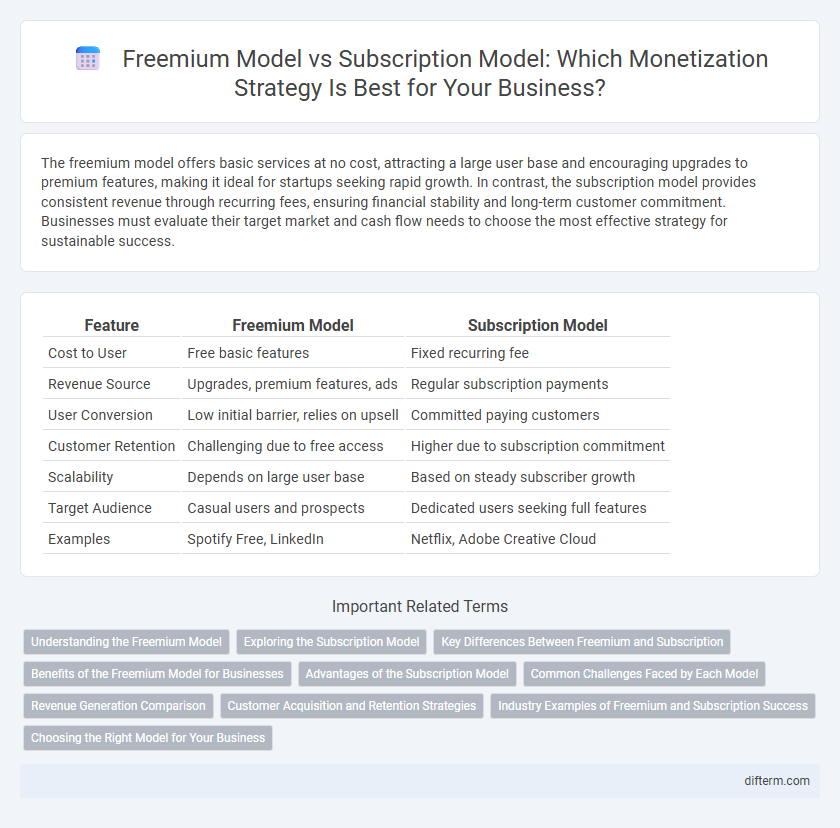The freemium model offers basic services at no cost, attracting a large user base and encouraging upgrades to premium features, making it ideal for startups seeking rapid growth. In contrast, the subscription model provides consistent revenue through recurring fees, ensuring financial stability and long-term customer commitment. Businesses must evaluate their target market and cash flow needs to choose the most effective strategy for sustainable success.
Table of Comparison
| Feature | Freemium Model | Subscription Model |
|---|---|---|
| Cost to User | Free basic features | Fixed recurring fee |
| Revenue Source | Upgrades, premium features, ads | Regular subscription payments |
| User Conversion | Low initial barrier, relies on upsell | Committed paying customers |
| Customer Retention | Challenging due to free access | Higher due to subscription commitment |
| Scalability | Depends on large user base | Based on steady subscriber growth |
| Target Audience | Casual users and prospects | Dedicated users seeking full features |
| Examples | Spotify Free, LinkedIn | Netflix, Adobe Creative Cloud |
Understanding the Freemium Model
The freemium model offers basic services for free while charging for premium features, enabling businesses to attract a broad user base and convert a portion into paying customers. This approach leverages user experience to demonstrate value before purchase, reducing customer acquisition costs compared to traditional subscription models. Companies employing the freemium strategy benefit from scalable growth and valuable user data that can inform product development and targeted marketing efforts.
Exploring the Subscription Model
The subscription model generates recurring revenue by charging customers a fixed fee at regular intervals, enhancing cash flow predictability and customer lifetime value. It supports scalable growth through tiered pricing plans tailored to diverse customer segments, increasing market reach and retention rates. Key metrics such as Monthly Recurring Revenue (MRR) and churn rate are critical for optimizing performance and sustaining profitability in subscription-based businesses.
Key Differences Between Freemium and Subscription
The freemium model offers basic services at no cost while charging for premium features, enabling wide user acquisition and gradual monetization through upgrades. In contrast, the subscription model requires users to pay a recurring fee for full access, ensuring steady and predictable revenue streams. Key differences include user commitment level, revenue predictability, and the balance between free access and paid features.
Benefits of the Freemium Model for Businesses
The Freemium Model offers businesses a cost-effective strategy to attract a large user base by providing free access to basic features, enhancing brand awareness and user engagement. This model facilitates upselling opportunities by converting free users into paying customers through premium feature offerings, optimizing revenue streams. It also enables data collection and user behavior analysis, helping businesses refine products and tailor marketing strategies for increased customer retention and growth.
Advantages of the Subscription Model
The Subscription Model offers predictable and recurring revenue streams that enhance financial stability and facilitate long-term business planning. It enables deeper customer engagement through ongoing service delivery and personalized experiences, increasing customer retention and lifetime value. Subscription services also provide valuable data insights into user behavior, allowing companies to optimize offerings and target marketing efforts effectively.
Common Challenges Faced by Each Model
Freemium models often struggle with converting free users to paying customers, leading to high user acquisition costs without guaranteed revenue. Subscription models face challenges in maintaining long-term customer retention and reducing churn rates, requiring constant value delivery and engagement. Both models must address pricing strategy complexities and balance perceived value to optimize profitability.
Revenue Generation Comparison
The subscription model generates more consistent and predictable revenue through recurring payments, enhancing cash flow stability for businesses. In contrast, the freemium model attracts a larger user base by offering free access but relies heavily on converting a small percentage of those users to paid plans, which can result in slower revenue growth. Companies employing the subscription model typically achieve higher customer lifetime value (CLV) and lower churn rates, driving stronger long-term revenue performance.
Customer Acquisition and Retention Strategies
The freemium model drives customer acquisition by lowering entry barriers, allowing users to experience core features without cost, thereby increasing the user base rapidly. In contrast, the subscription model emphasizes customer retention through ongoing value delivery and predictable revenue streams, fostering long-term loyalty. Combining freemium's initial engagement with subscription's sustained commitment can optimize both acquisition and retention strategies effectively.
Industry Examples of Freemium and Subscription Success
Spotify illustrates the freemium model's effectiveness by offering free access with ads, converting millions into paying subscribers for premium features. Netflix exemplifies subscription success through its consistent revenue growth, driven by exclusive content and global reach. Both models leverage distinct strategies to balance user acquisition and monetization, influencing industries from music streaming to video entertainment.
Choosing the Right Model for Your Business
Selecting the optimal pricing strategy depends on your target market, product type, and revenue goals. The freemium model attracts a broad user base by offering core features free, driving user acquisition and upselling premium features. Subscription models provide predictable revenue streams by charging customers recurring fees for full access, ideal for businesses emphasizing long-term customer retention and stable cash flow.
Freemium Model vs Subscription Model Infographic

 difterm.com
difterm.com